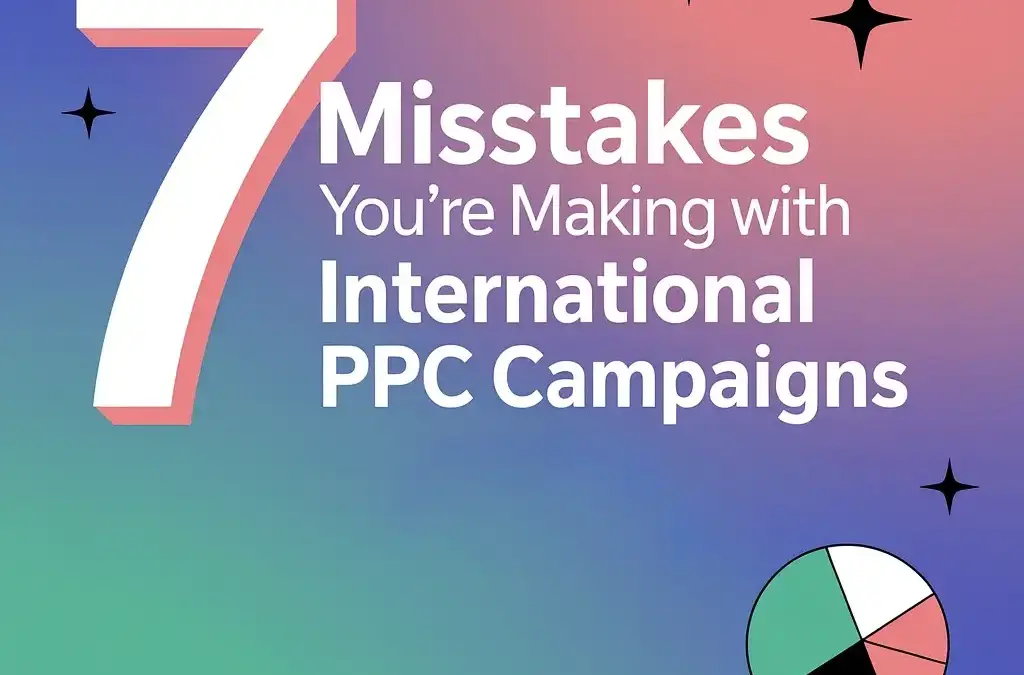International PPC campaigns offer tremendous growth opportunities, but they're also where marketing budgets go to die spectacular deaths. While most businesses dream of global expansion, the reality is that international PPC efforts often fail because marketers treat global markets like a simple copy-paste operation from their domestic campaigns.
The truth? International PPC requires a completely different approach. Cultural nuances, local search behaviors, and market-specific strategies can make or break your campaigns before they even get started.
Let's dive into the seven most common mistakes that are probably costing you money right now: and more importantly, how to fix them.
Mistake #1: Relying on Direct Translations Instead of Localization
This is the big one. The most devastating mistake in international PPC is assuming that Google Translate can handle your keyword research and ad copy. When you simply translate your English keywords word-for-word, you miss how people actually search in different markets.
Here's a reality check: What Americans call "sneakers," British users search for as "trainers." Germans might search for "Turnschuhe" or "Sportschuhe" depending on the specific type. These aren't just vocabulary differences: they represent completely different search intents and purchase behaviors.
The Fix: Work with native speakers or professional localization specialists, not translation tools. Conduct fresh keyword research in each target market to understand local search terminology and colloquialisms.
Start by analyzing what terms locals actually use on social media, forums, and review sites. Use Google's Keyword Planner in each target country to see actual search volumes and related terms. You'll often discover that locals use completely different phrases than what direct translation would suggest.

Mistake #2: Treating All International Markets the Same
Just because two countries speak the same language doesn't mean they behave the same way. Users in Germany are typically more detail-oriented and value quality over price. French users might prioritize style and brand prestige. Meanwhile, users in Southeast Asia might be more price-sensitive and mobile-first in their approach.
Assuming your German audience behaves like your Austrian audience, or that your messaging resonates equally across all European markets, leads to poorly targeted campaigns that waste budget on irrelevant traffic.
The Fix: Research each market's unique characteristics by diving deep into local data. Use Google Analytics to segment your existing traffic by country and analyze behavior patterns. Look at bounce rates, session duration, and conversion paths by region.
Talk to your sales team about regional differences they've noticed. Customer service representatives often have golden insights about what concerns different markets have. Create market-specific personas that reflect not just demographics, but cultural values and purchasing motivations.
Mistake #3: Poor Geographic and Language Targeting Setup
This mistake is more common than you'd think. Marketers often set up sloppy geo-targeting that results in showing German ads to English speakers living in Germany, or blasting English ads in regions where English isn't widely spoken.
Even worse is the "spray and pray" approach where you target entire continents with the same campaign. This makes it impossible to optimize effectively because you're averaging good performance with terrible performance.
The Fix: Create dedicated campaigns for each geographic location and language combination. Don't just set broad European targeting: break it down by country, and then by language within each country.
Set precise geographic boundaries that align with your business capabilities. If you can't ship to certain regions or provide customer support in local time zones, don't target those areas. Use location targeting options strategically: "People in" your target locations, not "People interested in" those locations.

Mistake #4: Using Generic, One-Size-Fits-All Landing Pages
You've spent time and money getting international visitors to click your ads, and then you drop them onto the same generic landing page regardless of their location, language, or cultural context. This dramatically reduces conversion rates and wastes your advertising spend.
Generic landing pages fail because they don't address local concerns, use unfamiliar currencies, or showcase testimonials from customers that international visitors can't relate to.
The Fix: Develop localized landing pages that reflect regional preferences and cultural norms. This goes beyond translation: you need to consider local business practices, preferred payment methods, and trust signals that resonate with each market.
Include appropriate currencies, local contact information, and region-specific testimonials. Use imagery that reflects local demographics and preferences. Ensure your pages load quickly in target regions by using content delivery networks (CDNs) with local servers.
Don't forget compliance requirements. GDPR in Europe, different privacy laws in various countries: make sure your landing pages meet local legal requirements.
Mistake #5: Ignoring Cultural Differences in Creative and Copy
What works in your home market might be completely inappropriate or ineffective in another culture. Colors, imagery, messaging tone, and even the concept of urgency can vary dramatically between cultures.
For example, red is associated with luck and prosperity in China but can signify danger or warning in Western cultures. Direct, aggressive sales copy that works in the US might come across as rude or pushy in Japan.
The Fix: Research local aesthetic preferences and cultural sensitivities before creating ad creative. This isn't just about avoiding offensive content: it's about creating ads that feel natural and appealing to local audiences.
Study successful local competitors to understand what visual and messaging approaches resonate. Test different color schemes that align with regional preferences while maintaining your brand guidelines.
Consider seasonal and cultural events that might impact your messaging timing and relevance. Chinese New Year, Ramadan, local holidays: these all affect when and how you should communicate with different markets.

Mistake #6: Misallocating Budgets Across Markets
Many marketers assume all international markets will perform similarly and allocate budgets based on market size or gut feelings rather than actual performance data. This leads to overspending in underperforming regions while missing opportunities in high-potential markets.
Without proper performance segmentation by region, you might be averaging strong performance in Germany with poor results in France, missing critical optimization opportunities.
The Fix: Start with small test budgets in each market before scaling. Resist the urge to go big immediately: international PPC requires a methodical approach to budget allocation.
Analyze performance data at the country or city level, not just overall campaign performance. Set up proper tracking and reporting that allows you to see which geographic regions are driving the best ROI.
Allocate budgets based on actual performance metrics: cost per acquisition, lifetime value by region, and conversion rates. Some markets might have higher costs but also higher customer lifetime values, making them more profitable in the long run.
Mistake #7: Failing to Understand Local Compliance and Competition
Running international ads without understanding local advertising regulations can result in disapproved ads, wasted spend, or even legal issues. Each country has different rules about what you can and cannot say in advertising, especially for regulated industries like finance, healthcare, or legal services.
Additionally, ignoring local competitors means missing crucial insights about market positioning, pricing strategies, and messaging that actually works with local audiences.
The Fix: Research advertising compliance requirements for each target market before launching campaigns. This includes understanding local advertising standards, required disclaimers, and industry-specific regulations.
Study your local competitors extensively. What messaging do they use? How do they position themselves? What prices are they advertising? This competitive intelligence is goldmine for optimizing your own campaigns.
Consider partnering with local experts or experienced international PPC agencies who understand regional advertising laws and market dynamics. They can provide insights into local ad trends, help navigate compliance requirements, and optimize campaigns based on regional best practices.
Ready to Fix Your International PPC Campaigns?
International PPC success isn't about scaling your domestic campaigns: it's about creating entirely new, culturally-aware campaigns that resonate with local audiences. Each market is unique, with distinct characteristics, preferences, and behaviors that require specific approaches.
The businesses that succeed internationally are those that invest in understanding their target markets deeply, rather than assuming what works at home will work everywhere else. By avoiding these seven critical mistakes and implementing market-specific strategies, you can build scalable, high-performing international campaigns that drive genuine business growth.
Remember: international expansion is a marathon, not a sprint. Start small, test thoroughly, and scale based on data rather than assumptions. Your future global success depends on getting these fundamentals right from the beginning.





